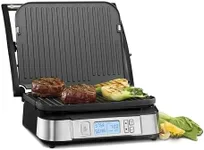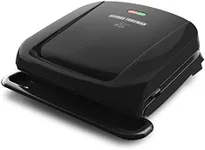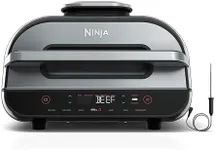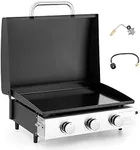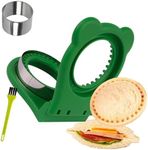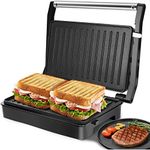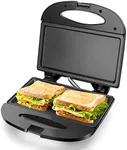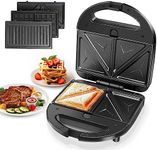Buying Guide for the Best The Indoor Grills
Choosing the right indoor grill can make a big difference in your cooking experience. Indoor grills are a great way to enjoy grilled food without having to go outside, and they come in a variety of styles and sizes to suit different needs. When selecting an indoor grill, it's important to consider several key specifications to ensure you get the best fit for your cooking habits and preferences.Grill TypeThere are several types of indoor grills, including contact grills, open grills, and grill pans. Contact grills have two heated surfaces that press together to cook food on both sides simultaneously, making them great for sandwiches and quick meals. Open grills have a single cooking surface and mimic the experience of outdoor grilling, ideal for larger cuts of meat and vegetables. Grill pans are stovetop options that provide grill marks and are versatile for various cooking methods. Choose a grill type based on the kinds of foods you plan to cook and your preferred cooking style.
Cooking Surface AreaThe cooking surface area determines how much food you can cook at once. Smaller grills with a cooking surface of around 60-80 square inches are suitable for individuals or small households. Medium-sized grills with 80-120 square inches are good for small families or those who entertain occasionally. Larger grills with over 120 square inches are ideal for bigger families or frequent entertainers. Consider your typical cooking volume and choose a grill that can accommodate your needs without overcrowding the cooking surface.
Temperature ControlTemperature control is crucial for achieving the desired cooking results. Basic models may have a single temperature setting, which can limit your cooking options. More advanced grills offer adjustable temperature controls, allowing you to cook a wider variety of foods at the optimal temperature. Some grills even have specific settings for different types of food, such as meat, fish, or vegetables. If you plan to cook a diverse range of dishes, look for a grill with precise and adjustable temperature controls.
Non-Stick SurfaceA non-stick surface makes cooking and cleaning much easier. It prevents food from sticking to the grill, reducing the need for excessive oil and making it easier to achieve perfect grill marks. Non-stick surfaces also simplify cleanup, as food residue can be wiped away effortlessly. When choosing a grill, consider the quality of the non-stick coating. Higher-end models often have more durable and long-lasting non-stick surfaces, which can be a worthwhile investment if you plan to use the grill frequently.
Removable PlatesRemovable plates are a convenient feature that makes cleaning your grill much easier. Grills with removable plates allow you to take out the cooking surfaces and wash them separately, either by hand or in the dishwasher. This feature is especially useful if you cook foods that tend to leave a lot of residue. If ease of cleaning is a priority for you, look for a grill with removable and dishwasher-safe plates.
Drip TrayA drip tray collects excess fat and juices that run off during cooking, helping to keep your kitchen clean and making the grill healthier by reducing the amount of fat in your food. Some grills have built-in drip trays, while others have removable ones. A removable drip tray is easier to clean and empty. If you are health-conscious or want to minimize mess, choose a grill with an efficient and easy-to-clean drip tray.
Size and StorageThe size of the grill is an important consideration, especially if you have limited counter or storage space. Compact grills are easier to store and are ideal for small kitchens or apartments. Larger grills may offer more cooking surface but require more storage space. Consider where you will keep the grill when it's not in use and choose a size that fits your available space. Some grills also have foldable designs or come with storage solutions to make them more convenient to store.
